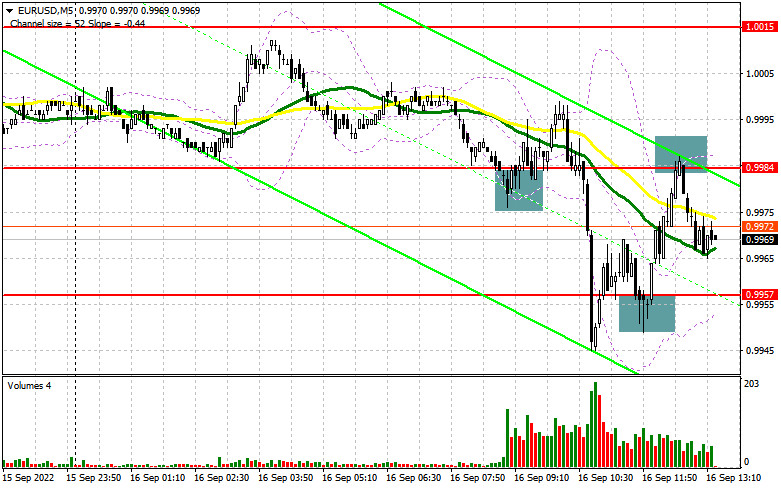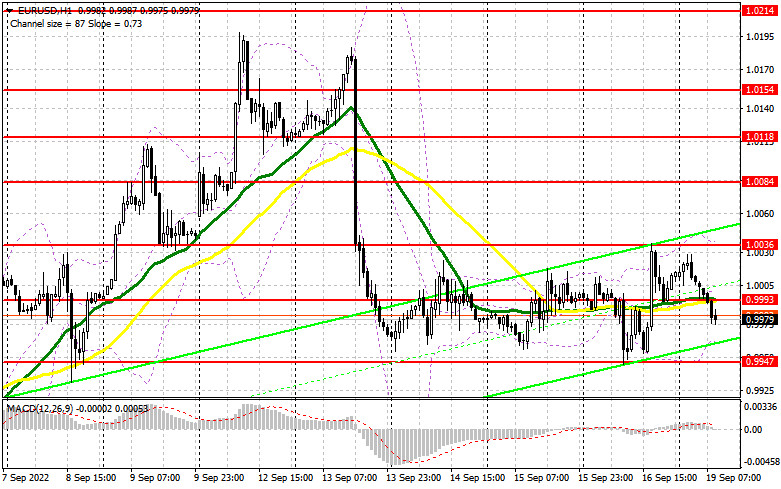
Several entry signals were formed on Friday. Let's have a look at the 5-minute chart to see what happened there. In my morning review, I outlined the level of 0.9984 and mentioned it as a good point for entering the market. As buyers were fighting for the support level of 0.9984, a good buy signal was formed in the first half of the day. However, the pair failed to show considerable growth. After a rise of 11 pips, bears pushed the pair down to 0.9984 and then lower to 0.9957. A false breakout at this point created a good buy signal. As a result, the pair recovered by 30 pips and hit the resistance zone of 0.0084.

For long positions on EUR/USD:
Weak macroeconomic data from the US stopped the bears from closing the day below the lower boundary of the sideways channel. So, the pair stayed in the range of 0.9947-1.0036, making it just a little bit wider. Today, nothing interesting is expected in the eurozone apart from the speeches of the ECB members, Luis De Guindos and Andrea Enria. In addition, the officials of Germany's Bundesbank will be speaking today. Usually, their stance on monetary policy is more hawkish. The fact that the ECB is planning to hike rates further keeps the euro afloat. This is especially crucial for the euro after the data released on Friday showed that inflation in the EU is rising. In the Asian session on Monday, the euro has already depreciated notably against its American rival. Therefore, It is better to postpone buying the pair while the pressure stays high. The best scenario in this case would be to wait for a false breakout of the support area of 0.9947 which serves as a lower boundary of the sideways channel. This will create a good entry point considering a bigger upside correction ahead with the target at 0.9993. This is where the two moving averages supporting the bearish trend are located. Hawkish comments by the ECB officials may prop up the euro. Therefore, a breakout and a downward test of the 0.9993 level will trigger stop-loss orders set by bears. This will create an additional signal for going long with a possible rise towards 1.0036. The resistance of 1.0084 will act as an upper target where I recommend profit taking. If EUR/USD declines and bulls are idle at 0.9947, the pair will come under more pressure. The best moment to open long positions will be a false breakout of the low of 0.9902. Going long right after a rebound will be possible only from the level of 0.9867 or even lower from 0.9819. Bear in mind a possible upside correction of 30-35 pips within the day.
For short positions on EUR/USD:
Although bears have loosened their grip lately, they are still strong near the upper boundary of the sideways channel. The longer the pair stays below 1.0000, the more likely is the euro to fall further. It may even retest yearly lows, especially if the Fed introduces more rate hikes this Wednesday. This is why sellers need to protect the resistance area of 0.9993 found in the middle of the sideways channel. The pair may test this level following the speech of the Bundesbank officials. I expect large market players to step in near the level of 0.9993. So after a false breakout, you can open short positions with the downward target found at 0.9947. A breakout of this level and a strong hold below it followed by an upward retest will generate an additional sell signal that will trigger stop-loss orders set by the bulls. As a result, the pair may plunge deeper towards the lower line of the sideways channel at 0.9902. I recommend taking profit at this point. The low of 0.9867 will serve as a more distant target. If EUR/USD jumps to the upside in the European session while bears are idle at 0.9993, the demand for the euro will increase but sellers have nothing to worry about. An upside correction will bring the price to the next resistance level of 1.0036. In this case, I recommend opening short positions at 1.0036 only if there is a false breakout. Selling EUR/USD right after a rebound is possible from the high of 1.0084 or even higher - from 1.0118. Keep in mind a possible downward correction of 30-35 pips within the day.

COT report:
The Commitment of Traders report for September 6 showed a decrease in short positions and a sharp rise in the long ones. This is hardly surprising given that these changes came ahead of the ECB's meeting where the regulator raised the rate straight by 0.75%. As the gap between the rates of the ECB and the Fed is slowly narrowing, the demand for the European currency will gradually recover. At the same time, we should be aware of the difficulties the European economy is facing now and is going to face this winter due to soaring energy prices. Meanwhile, the US Federal Reserve is going to raise the rate by another 0.75% as soon as this week. Yet, the decision of the regulator will largely depend on the fresh inflation data. If consumer prices keep accelerating, the US central bank's decision will be obvious. According to the COT report, long positions of the non-commercial group of traders rose by 3,019 to 205,277, while short positions decreased by 8,308 to 241,626. By the end of the week, the net non-commercial position increased to -36,349 from -487,676, indicating the first signs that an upside correction is being formed and the pair has hit the bottom. The weekly closing price declined to 0.9917 from 1.0033.
Indicator signals:
Moving Averages
Trading near the 30- and 50-day moving averages indicates market uncertainty.
Please note that the time period and levels of the moving averages are analyzed only for the H1 chart, which differs from the general definition of the classic daily moving averages on the D1 chart.
Bollinger Bands
In case of a decline, the lower band of the indicator at 0.9978 will act as support. If the pair advances, the upper band of the indicator at 1.0036 will serve as resistance.
Description of indicators:
• A moving average of a 50-day period determines the current trend by smoothing volatility and noise; marked in yellow on the chart;
• A moving average of a 30-day period determines the current trend by smoothing volatility and noise; marked in green on the chart;
• MACD Indicator (Moving Average Convergence/Divergence) Fast EMA with a 12-day period; Slow EMA with a 26-day period. SMA with a 9-day period;
• Bollinger Bands: 20-day period;
• Non-commercial traders are speculators such as individual traders, hedge funds, and large institutions who use the futures market for speculative purposes and meet certain requirements;
• Long non-commercial positions represent the total number of long positions opened by non-commercial traders;
• Short non-commercial positions represent the total number of short positions opened by non-commercial traders;
• The total non-commercial net position is the difference between short and long positions of non-commercial traders.